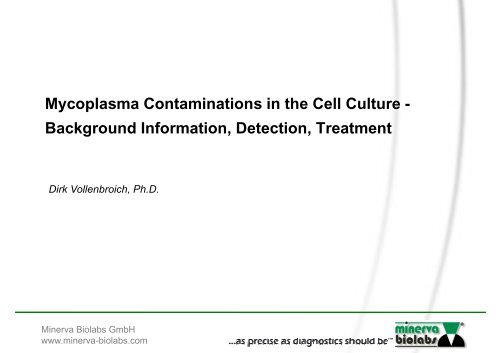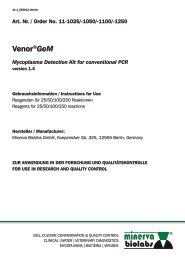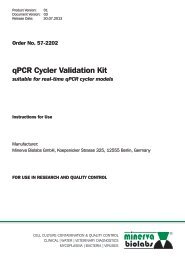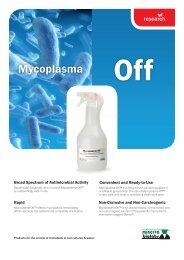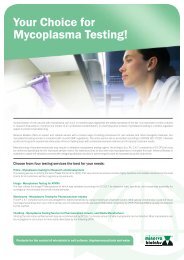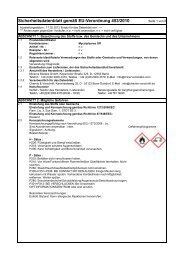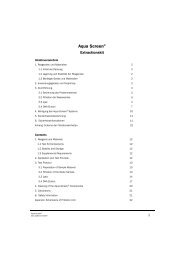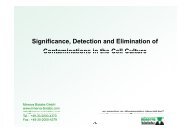Mycoplasma Contaminations in the Cell Culture ... - Minerva Biolabs
Mycoplasma Contaminations in the Cell Culture ... - Minerva Biolabs
Mycoplasma Contaminations in the Cell Culture ... - Minerva Biolabs
You also want an ePaper? Increase the reach of your titles
YUMPU automatically turns print PDFs into web optimized ePapers that Google loves.
<strong>Mycoplasma</strong> <strong>Contam<strong>in</strong>ations</strong> <strong>in</strong> <strong>the</strong> <strong>Cell</strong> <strong>Culture</strong> -<br />
Background Information, Detection, Treatment<br />
Dirk Vollenbroich, Ph.D.<br />
M<strong>in</strong>erva <strong>Biolabs</strong> GmbH<br />
www.m<strong>in</strong>erva-biolabs.com
<strong>Cell</strong> Threats<br />
• Contam<strong>in</strong>ation with o<strong>the</strong>r cell l<strong>in</strong>es<br />
• Yeast<br />
• Fungi<br />
• Viruses:<br />
especially bov<strong>in</strong>e Pestiviruses<br />
BVDV – Virus of Bov<strong>in</strong>e Virus diarrhea<br />
CSFV – Virus of <strong>the</strong> classical l sw<strong>in</strong>e<br />
but also BDV (Borna Disease Virus)<br />
• Bacteria<br />
• <strong>Mycoplasma</strong>
<strong>Mycoplasma</strong><br />
• Found <strong>in</strong>1898 classified as virus<br />
• Bacteria, orig<strong>in</strong> <strong>in</strong> gram-positive Bacillus/Lactobacillus/ Streptococcus l<strong>in</strong>e,<br />
but own class<br />
• Colloquial: l <strong>Mycoplasma</strong> or PPLO (pleuropneumonia-like lik organism)<br />
• Class of Mollicutes (soft sk<strong>in</strong>) with <strong>the</strong> families:<br />
‣ <strong>Mycoplasma</strong>taceae: <strong>Mycoplasma</strong> (animal), Ureaplasma (animal)<br />
‣ Acholeplasmataceae: Acholeplasma (animal, plant)<br />
‣ Spiroplasmataceae: Spiroplasma (plant, anthropodes, rodent)<br />
‣ Anaeroplasma (rum<strong>in</strong>ant)
<strong>Mycoplasma</strong> (cont<strong>in</strong>ued)<br />
• Pass cellulose- and polyv<strong>in</strong>yl filter with 0,45 µm pore width<br />
• Smalles, self-replicat<strong>in</strong>g organisms (0,3 to 0,8 µm, 600 kb to 1700 kb (1/5 of<br />
E. coli-genome) with approx. 500 genes<br />
• Need to consume cholesterol, l am<strong>in</strong>o acids, fatty acids, vitam<strong>in</strong>s i and o<strong>the</strong>r<br />
catabolites<br />
• Typically arg<strong>in</strong><strong>in</strong>e, glucose or urea metabolism<br />
• Lacks cell wall, but has simple plasma membrane<br />
– extremely flexible <strong>in</strong> relation to environment, however sensitive <strong>in</strong> relation to<br />
chemical <strong>in</strong>fluences<br />
– resistant to penicill<strong>in</strong>, conta<strong>in</strong>s no peptido p glycan gy wall<br />
– osmotically unstable<br />
• Occurr<strong>in</strong>g extra cellularly, only <strong>in</strong> rare cases <strong>in</strong>tracellularly
<strong>Mycoplasma</strong> (cont<strong>in</strong>ued)<br />
• Parasites for humans, animals, plants, <strong>in</strong>sects, etc.<br />
• Effects latent <strong>in</strong>fections of human be<strong>in</strong>gs<br />
respiratory tract : M. pneumoniae<br />
genital tract: M. genitalium, Ureaplasma urealyticum, M. hom<strong>in</strong>is<br />
jo<strong>in</strong>ts:<br />
M. fementans, M. arthritidis<br />
central nerve system: M. pneumoniae<br />
heart:<br />
M. pneumoniae<br />
• Effects on plants:<br />
blossom green<strong>in</strong>g (clover, strawberry)<br />
yellow<strong>in</strong>g, stall (v<strong>in</strong>e, pear, ster)<br />
midget growth (rice)<br />
sproud shoot<strong>in</strong>g (appel)<br />
transfer by cicada and leaf fleas<br />
• Average cell culture contam<strong>in</strong>ation rate:<br />
5 % <strong>in</strong> <strong>in</strong>dustry, 47 % <strong>in</strong> academics
<strong>Mycoplasma</strong><br />
awaited <strong>the</strong> development of <strong>the</strong> cell culture<br />
<strong>in</strong> order to f<strong>in</strong>d <strong>the</strong>ir actual biological niche.
<strong>Mycoplasma</strong> <strong>in</strong> <strong>the</strong> Electron Microscope<br />
Bov<strong>in</strong>ce cell l<strong>in</strong>e MDBK<br />
(a) without and (b) with <strong>Mycoplasma</strong><br />
Source: Lünsdorf & Rohde,<br />
GBF Braunschweig<br />
BG Chemistry BookletB 004
Effects on <strong>Cell</strong> <strong>Culture</strong><br />
• Inhibition of cell proliferation up to 50% by nutrient withdrawal and secretion<br />
of harmful metabolic products<br />
McGarrity et al. (1984) In Vitro <strong>Cell</strong>. Dev. Biol. 20:1<br />
• fast glucose reduction and formation of acids => p H shift<br />
• arg<strong>in</strong><strong>in</strong>e depletion => <strong>in</strong>hibition of prote<strong>in</strong> biosyn<strong>the</strong>sis, cell division and growth<br />
• Influence of immunological reactions<br />
(macrophage activation, <strong>in</strong>hibition of antigen presentation, ti <strong>in</strong>duction of signal transduction)<br />
ti Mühlradt et al. (1996) Biochemistry 35:7781<br />
• Influence of virus proliferation and <strong>the</strong> <strong>in</strong>fection rate<br />
Nar-Paz et al.(1995) FEMS Microbiol. Lett. 128:63<br />
• Cause chromosomal aberrations and multiple translocations<br />
McGarrity et al. (1978) In: <strong>Mycoplasma</strong> <strong>in</strong>fection of cell cultures. Plenum Press S. 213ff<br />
• Disturbance of <strong>the</strong> hybridoma technique, contam<strong>in</strong>ated cells become<br />
sensitive ii <strong>in</strong> HAT medium
Effects on <strong>Cell</strong> <strong>Culture</strong>s (cont<strong>in</strong>ued)<br />
• Accumulation of mycoplasma at cells wall alters cell wall <strong>in</strong>tegrity<br />
• Significant changes <strong>in</strong> micro array and gene expression profiles<br />
bio<strong>in</strong>formatics.picr.man.ac.uk/experiments/mycoplasma/<br />
• <strong>Mycoplasma</strong> can constitute t up to 50% of <strong>the</strong> total t prote<strong>in</strong> and 15- 30% of<br />
<strong>the</strong> isolated DNA<br />
• Decrease of <strong>the</strong> transfection rates by 5% through electroporation<br />
• Induction of leopard cells (condensation of <strong>the</strong> chromat<strong>in</strong>s)<br />
Influence almost all functions of <strong>the</strong> host cell metabolism
Frequency and Source of <strong>Mycoplasma</strong> Species<br />
Occurr<strong>in</strong>g <strong>in</strong> <strong>Cell</strong> <strong>Culture</strong>s (Literature comparison)<br />
20,2 %<br />
25,3 %<br />
A. laidlawii<br />
o<strong>the</strong>rs<br />
9%<br />
18% M. arg<strong>in</strong><strong>in</strong>ii<br />
17%<br />
M. hyorh<strong>in</strong>is<br />
20%<br />
M. salivarium<br />
5%<br />
36,9 %<br />
M. orale<br />
23%<br />
M. hom<strong>in</strong>is<br />
5%<br />
M. fermentans<br />
3%
Sources of Contam<strong>in</strong>ation<br />
• Primary cultures from <strong>the</strong> orig<strong>in</strong>al tissue<br />
(<strong>in</strong>cidence approximately 4 %)<br />
• Cross contam<strong>in</strong>ation<br />
• contam<strong>in</strong>ated cultures<br />
• new cultures from unknown sources, also partly from cell banks<br />
• virus suspensions, antibody- solutions or o<strong>the</strong>r additions of contam<strong>in</strong>ated cell<br />
cultures<br />
• Direct contam<strong>in</strong>ation<br />
• serum (only treated serums, e.g. UV or γ-radiated are presumably mycoplasma<br />
free)<br />
• laboratory <strong>in</strong>struments, media and reagents, which came <strong>in</strong>to contact with<br />
contam<strong>in</strong>ated cultures
Sources of Contam<strong>in</strong>ation (cont<strong>in</strong>ued)<br />
• The User<br />
• direct entry while handl<strong>in</strong>g, usually from <strong>the</strong> oral flora<br />
• droplet transfer<br />
• lack<strong>in</strong>g dis<strong>in</strong>fection<br />
• careless technical work<br />
From:Toni L<strong>in</strong>dl, Zell-und Gewebekultur
Importance of <strong>the</strong> <strong>Mycoplasma</strong> Tests<br />
• <strong>Cell</strong> cultures offer ideal liv<strong>in</strong>g conditions to parasitic mycoplasma:<br />
contam<strong>in</strong>ation is possible at any time<br />
• Despite titers from 10 7 to 10 8 mycoplasma/ml <strong>in</strong> cell cultures, no apparent<br />
projection referr<strong>in</strong>g to <strong>the</strong> contam<strong>in</strong>at<strong>in</strong>g mycoplasma species and <strong>the</strong> cell<br />
type<br />
• Microscopically unrecognizable<br />
• Standard antibiotics can allow contam<strong>in</strong>ation levels lower than detection<br />
levels, Pen/Strep does not provide protection from contam<strong>in</strong>ation<br />
!! only each 10th cell culture user regularly tests<br />
for mycoplasma contam<strong>in</strong>ation !!
Instruction for Test<strong>in</strong>g<br />
• Regulations:<br />
FDA Po<strong>in</strong>ts to Consider (May 1993), Regularien 21CFR610.30<br />
USDA federal code #9CFR113.28<br />
European Pharmacopoeia 267 2.6.7, Suppl. 58 5.8<br />
ICH Guidel<strong>in</strong>e for biotechnological/biological products<br />
• Obliged to test:<br />
Master cell cultures, cell cultures, virus stocks, control cell cultures<br />
Bioproducts from cell cultures (antibodies, hormons, immune stimulators, blood<br />
products from cell cultures)<br />
Vacc<strong>in</strong>es for humans and <strong>the</strong> veter<strong>in</strong>ary field<br />
• Test necessary for:<br />
Editors who are aware of <strong>the</strong> significance of mycoplasma contam<strong>in</strong>ation
Fluorescence method<br />
• Simple, direct <strong>in</strong>dicator for vital mycoplasma<br />
• Little operative expense, but very time<br />
consum<strong>in</strong>g<br />
• Poor <strong>in</strong>dicator for mycoplasma species with<br />
tendencies of extra cellular cell absorption via<br />
cytadherent prote<strong>in</strong>s<br />
• Sem<strong>in</strong>ars and experience required<br />
• Eur. Ph.-listed evidence
<strong>Culture</strong> method<br />
• Strict requirements for <strong>the</strong> culture<br />
medium and growth conditions<br />
(aerobic/anaerobic), generally<br />
requires non-standard adjustments<br />
for <strong>the</strong> <strong>in</strong>dividual id species<br />
• Extremely long test<strong>in</strong>g times of 1 to<br />
4 weeks<br />
• Difficult analysis<br />
• Broth and disk possible<br />
• Advantage: only liv<strong>in</strong>g mycoplasma<br />
is detected<br />
t d<br />
• Sensitivity: 1 CFU corresponds to<br />
average 30 GU<br />
M. arg<strong>in</strong><strong>in</strong>ii<br />
Source: <strong>Mycoplasma</strong> Experience Ltd.<br />
bar = 1 mm
NAT method<br />
• Nucleic acid amplication test with primers and<br />
commercial kits free of choice<br />
• Eur. Ph. 2.6.7, v 5.8, valid s<strong>in</strong>ce 01. July 2007<br />
• Validation must show equality to established<br />
methods accord<strong>in</strong>g sensitivity, specificity, and<br />
robustness<br />
• Can replace <strong>in</strong>dicator methods if sensitivity below<br />
100 cfu/ml<br />
• Can replace culture method if sensitivity is below<br />
10 CFU/ml<br />
• Can replace both methods if results are required<br />
quickly<br />
• <strong>Cell</strong> culture enrichement possible to <strong>in</strong>crease<br />
sensitivity
Alternative ti <strong>Mycoplasma</strong> Diagnostic Methods<br />
Method<br />
Necessary Devices and Evaluation<br />
Biochemical Verification Methods<br />
comb<strong>in</strong>ed with lum<strong>in</strong>escence detection<br />
Biochemical Verification Methods<br />
Adenos<strong>in</strong>phosphorylase Test<br />
(6-MPDR-Test)<br />
Enzyme Immuno Verification<br />
requires lum<strong>in</strong>escence reader, low sensitivity<br />
of approx. 10 5 CFU per test, high demands<br />
for sample quality<br />
easy usable<br />
none / requires <strong>in</strong>dicator cell l<strong>in</strong>e, low<br />
sensitivity, easily performed<br />
ELISA-Reader / specific for mycoplasma<br />
species, <strong>in</strong>termediate sensitivity (10 6 /ml),<br />
time <strong>in</strong>tensive
Features of Venor ® GeM<br />
• Validated accord<strong>in</strong>g to Eur. Ph. 2.6.7, 5.8<br />
• Recommended by <strong>the</strong> WHO<br />
• More than 100x cited <strong>in</strong> publications<br />
• Specific for > 25 mycoplasma species<br />
• Detection limit 1,5 copies/µL, LOD 95% = 4,5 copies/µl<br />
• Clear yes/no-result after 3 hours<br />
• Package sizes: 25, 50, 100 und 250 tests,<br />
• User friendly aliquotes á25tests<br />
tests.<br />
• Aliquots of Master-Mix can be stored frozen<br />
<strong>in</strong>clud<strong>in</strong>g hot-start Taq possible.<br />
• Also available for real-time PCR
Analysis us<strong>in</strong>g Venor ® GeM<br />
100 bp DNA ladder<br />
negative control / <strong>in</strong>ternal control amplification<br />
100.000 copies<br />
10.000 copies<br />
1000 copies<br />
100 copies<br />
10 copies<br />
1 copy
Frequency of Test<strong>in</strong>g<br />
• New cell and virus cultures<br />
• Each month for cont<strong>in</strong>uous cell l<strong>in</strong>es; each week <strong>in</strong> cases of laboratory<br />
contam<strong>in</strong>ation<br />
• Before each liquid nitrogen storage<br />
• Upon modification of <strong>the</strong> cell characteristics<br />
• In case of problems with result reproducibility
Procedure for Contam<strong>in</strong>ated <strong>Cell</strong> <strong>Culture</strong>s/ Virus<br />
• Isolate <strong>the</strong> culture immediately (<strong>in</strong>cubator and if possible autoclave)<br />
• Immediately lock and test cryo- conserves<br />
• Isolate all cryo-conserved samples<br />
• Inform all possible receipts<br />
• Standard dis<strong>in</strong>fection of <strong>the</strong> laboratory<br />
• Initiate immediately treatment with irreplaceable cells
<strong>Mycoplasma</strong> Elim<strong>in</strong>ation Methods<br />
• Antibiotics<br />
average activity: Ciprofloxac<strong>in</strong> (Ciprobay, Ciprox<strong>in</strong>), Doxycycl<strong>in</strong><br />
low activity:<br />
Plasmoc<strong>in</strong>, Chloramphenicol, Cl<strong>in</strong>damyc<strong>in</strong>, Azithromyc<strong>in</strong>,<br />
Clarithromyc<strong>in</strong>, Tetracycl<strong>in</strong>, Tiamul<strong>in</strong><br />
no activity:<br />
Penicill<strong>in</strong>, Streptomyc<strong>in</strong>, Polymyx<strong>in</strong>, Vancomy<strong>in</strong>, Erythromyc<strong>in</strong><br />
(only active aga<strong>in</strong>st some species), Cephalospor<strong>in</strong>e, Sulfametaxol,<br />
G418 (Genetic<strong>in</strong>, Gentamyc<strong>in</strong>-Analogon) Analogon), Bacitrac<strong>in</strong><br />
• Complement Fixation<br />
• Co-Cultivation with Macrophages<br />
• Physical and chemical methods<br />
heat <strong>in</strong>activation at 40-42 °C<br />
photo <strong>in</strong>activation with Hoechst 33258/5-Bromuracil<br />
liquid extraction<br />
• Autoclave
Effective Elim<strong>in</strong>ation with Mynox ® Gold<br />
Basically no cytotoxicity<br />
Highly effective:<br />
up to 100% permanent elim<strong>in</strong>ation with<br />
first treatment<br />
Universal for cells<br />
Universal for <strong>Mycoplasma</strong><br />
Low resistance risk<br />
Convenient Format<br />
Interoperable with o<strong>the</strong>r antibiotics
Effect of Mynox ® on <strong>Mycoplasma</strong><br />
Electron micrographs of m<strong>in</strong>k lung cells (ML cells), contam<strong>in</strong>ated with<br />
<strong>Mycoplasma</strong> hyorh<strong>in</strong>is<br />
Source: M. Özel, Robert-Koch-Institut Berl<strong>in</strong>
Recommendations for Improvement<br />
• Regularly and sensitive test<strong>in</strong>g (monthly); weekly test<strong>in</strong>g <strong>in</strong> cases of<br />
laboratory contam<strong>in</strong>ation<br />
• Operate free of standards antibiotics<br />
• Whenever possible: separate <strong>the</strong> work benches and <strong>in</strong>cubators for handl<strong>in</strong>g<br />
contam<strong>in</strong>ated and mycoplasma free materials<br />
• Never use conta<strong>in</strong>ed cultures; reject immediately or treatedt • Dis<strong>in</strong>fect work<strong>in</strong>g surfaces and hands with alcoholic spray before and after<br />
work<strong>in</strong>g procedures, or with <strong>the</strong> change of <strong>the</strong> work<strong>in</strong>g material<br />
• Quarant<strong>in</strong>e new cells of any orig<strong>in</strong> and <strong>in</strong>tegrate <strong>in</strong>to <strong>the</strong> laboratory only<br />
after test<strong>in</strong>g negative<br />
• For larger loads of serum, <strong>in</strong>cubate on <strong>in</strong>dicator cells 3T3 or Vero over 4<br />
passages before <strong>in</strong>tegration and use, and <strong>the</strong> test supernatants by means of<br />
PCR


